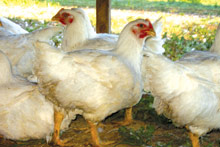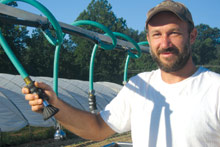Of all the many tasks farmers are called upon to do, from castrating livestock to mucking out stalls, few chores are more dreaded than killing chickens.

“It’s a nasty job,” says Stephen Robertson, who raises free-range Cornish Rock Cross birds on his hilly 40-acre farmstead in Madison County. “When we come down here Thursday nights to process, nobody’s smiling and telling jokes. The plucking and the gutting … it’s just not pleasant. I’d rather cut up a lamb.”
Killing a chicken is an especially labor-intensive procedure, even with the $1,100 plucker Robertson and his wife Dawn use at East Fork Farm. They usually end up using tweezers to nip at the hundreds of pin feathers the mechanized plucker doesn’t get, methodically stripping their birds completely clean. It takes more than two hours to prepare two dozen chickens for sale.
As the rising costs of food have goaded more sustenance farmers and urban gardeners into keeping chickens—“the guy at the store told me they’re moving more chicken feed than they ever have before,” Robertson says—some local food activists have started thinking about how to make processing more manageable.
Chicken starter kits are still sold by mail, same way they were in the 1950s, when border radio crackled with pitches urging listeners to “imagine all the fun you’re gonna have with baby chicks. You lead ‘em around on little leashes, give ‘em little names and when they grow up—you’re gonna eat ‘em!” The apparent simplicity of the small-scale chicken biz often appeals to farmers with a few dozen square feet of land to spare, who mistakenly equate ordering up a box of chickens with planting tomato vines or adding a row of flowers to their fields. One messy round of blood and feathers usually sets them straight, says Casey McKissick, owner of Crooked Creek Farms in Old Fort.
“People like chickens, they like raising chickens, but they’re not thinking about processing,” he says. “They end up in their kitchens at 3 o’clock in the morning with a knife and they’re like, ‘This sucks. I am never doing this again.’”

McKissick, who provides chickens for a long list of area restaurants and sells them at the Asheville City Market, suspects the aggravations associated with chicken processing have seriously inhibited the local commercial-meat scene, despite an unprecedented interest in locally raised chicken, lamb and beef. Demand for naturally produced proteins is spiking nationwide, McKissick says: “People are thinking about the origins of their meat.” But the number of Western North Carolina farmers selling their own meat products—as opposed to raising livestock for an international conglomerate like Tyson Foods—remains remarkably small.
Poultry farmers who process fewer than 1,000 birds a year are exempt from a state law requiring them to use an inspected processing plant, but they’re stuck with the hassles of on-farm slaughter. Farmers on the other side of the 1,000-chicken divide have no choice but to use inspected facilities, which means a mountain-grown chicken may very well have taken a long, environmentally unfriendly trip to eastern North Carolina on its way to your plate. Either way, the final stage of chicken farming isn’t easy or cheap.
Enter the Mobile Processing Unit, an ingenious Rube Goldberg-esque contraption McKissick likens to a medieval torture device. The wheeled chicken-processing plant, which runs about the same length as a typical galley kitchen, was designed to be towed behind a truck. McKissick hopes the trailer, which he’s dragged as far away as Boone, will lure more farmers into the chicken business. He’d like to get them hooked by 2010, when a newly approved chicken-processing plant is set to open alongside a landfill in McDowell County. The plant, partially funded by state grants, will process 25,000 chickens each year.
“For our part, we instigated this for partially selfish reasons,” McKissick admits. “I don’t want to see half a million dollars go to this plant, and then have it close down because there aren’t enough producers using it.”
So McKissick welded together a solution to the problem, creating a processing unit with all the fancy equipment a newcomer to chicken farming probably wouldn’t consider a sound investment. Few farmers are positioned to shell out $60,00 on an agricultural whim. But without professional-grade scalders and pluckers, they’re likely to end up back in their kitchens, cursing the day they ever considered raising chickens.
“When we first started, we had a copper kettle and some plastic tables in the yard,” McKissick recalls. “This is set up like a little mini-plant. It’s even got rubber mats. The deal is, it’s more than most farmers would buy.”
The gleaming silver unit is arranged in assembly-line fashion, with the chickens’ journeys starting at the back end. The birds, alive and flapping, are pressed head-first into silver cylinders that narrow to a yo-yo-sized opening. Whomever’s working the serrated knife—even with all the mechanical upgrades, it takes four people to operate the unit efficiently—slits the chicken’s exposed throat. Killing chickens is still a brutal enterprise.
“I’d rather eviscerate all day long than cut necks,” McKissick says.
After about two minutes, when the chickens are “done dancing,” as McKissick puts it, they’re dunked into a scalding bath, heated to 158 degrees, then spun around in a plucking pot walled with fifty rubber fingers. The birds emerge “looking like something to eat,” McKissick says. They’re then iced before being laid out on the eviscerating table, a surgically clean surface with spray-down hoses strung above it. McKissick is planning to cut a few holes in the table so that innards can be easily scraped into the trash.
“It sure beats a stump or the tailgate of a truck,” he says.
McKissick charges $45 a day for use of the unit; members of the Foothills Farms Cooperative get a $10 discount.
“It’s as reasonable as we can possibly make it,” he says.
McKissick acknowledges that many supporters of the local food movement still shudder at frank discussions of animal slaughter and might even oppose his efforts to make it easier to kill chickens. But he also knows Americans have a carnivorous streak that’s unlikely to be satisfied anytime soon. Food security, he maintains, depends on local meat production and initiatives like his Mobile Processing Unit.
“If we can do positive things like this for our farmers, that’s a positive thing,” he says.



As if I needed another reason to be vegan! This article made me sick.
I am sad to say I still eat chicken. I have a few chickens on my mini farm and they are like pets to me.I only use my chickens for the eggs. After they stop producing they are allowed to live their life as retirees. This article bummed me out and I am really not sure why it was published and especially published where the restaraunt reviews usually appear..I can bet anyone that comes here looking for a good food review won’t be venturing out for chicken after reading this. I know I won’t.
This article represents truth, which is what a free press should be about. If more people were informed about how animals are raised before consumption I think more would choose differently and maybe in turn America wouldn’t be so damn fat.
I would like to applaud Mr. Robertson – at the very least this man is doing his work with compassion vs outright greed. This article includes information that is obviously needed today for small yard farmers that are considering raising chickens for food. I have been considering getting some chickens myself and this article helps quite a bit.
Wow, reality, how interesting!!!!!!
Thanks!
I would like to applaud Mr. Robertson – at the very least this man is doing his work with compassion vs outright greed.
LOL. How exactly do you kill compassionately?
Maybe sing a lullaby to your victim? Give him or her a four-course meal before the slaughter? Or perhaps even some mind-numbing drugs? Oh, wait, these are chickens. Compassionate killing means slitting their throats. And I love how this quote nicely sums up the whole article:
“I’d rather eviscerate all day long than cut necks,” McKissick says.
Remind me not to invite this guy over. :P
I applaud Casey McKissick for taking the production of local foods into his own hands and trying to help others do the same. While being a carnivore or vegetarian is a choice, he’s helping to make local meat a viable choice. Thanks for stepping up Casey. The sustainability of local food production is an important topic. (Please save all the arguments about the sustainability of meat-eating as a whole. You make your choices and allow others to make theirs. This is far more sustainable than eating at a fast food restaurant or buying from big conglomerates. Issues are rarely black and white.) Appreciate those who are taking steps towards a better future.
Cassy I live in Texas and proccess chickens, turkeys and wild hogs. For myself and the food banks. I get the poultry from the 4H clubs that cull them till they get to, the one they want to show. I would like to build a moblie unit like yours if you don’t mind sending a picture.
The people that come to the food bank don’t complain, and it cuts the cost the food banks has to spend. Maybe a few of your critics go hungry for few days or weeks thier opinion would change.
I love living off the land.